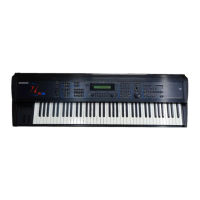Chapter 1ÑWelcome
ENSONIQ ZR-76 Musician's Manual16
If youÕve got a computer, and would like to use your favorite sequencing program to further develop your
sequences, you can pop your ZR-76 floppy into your computerÕs drive and load in your ZR-76 music. Any
computer that can read a DOS-formatted diskÑand that includes just about every recent type of
computerÑcan read the Standard MIDI files on an ZR-76 floppy.
The ZR-76 memory and floppy disk operations are described in Chapter 9ÑMemory and Storage.
EE
EE
NN
NN
SS
SS
OO
OO
NN
NN
II
II
QQ
QQ
EE
EE
XX
XX
PP
PP
SS
SS
ee
ee
rr
rr
ii
ii
ee
ee
ss
ss
WW
WW
aa
aa
vv
vv
ee
ee
EE
EE
xx
xx
pp
pp
aa
aa
nn
nn
ss
ss
ii
ii
oo
oo
nn
nn
BB
BB
oo
oo
aa
aa
rr
rr
dd
dd
ss
ss
aa
aa
nn
nn
dd
dd
MM
MM
RR
RR
--
--
FF
FF
LL
LL
AA
AA
SS
SS
HH
HH
BB
BB
oo
oo
aa
aa
rr
rr
dd
dd
ss
ss
The ZR-76 can be expanded with the addition of ENSONIQ EXP Series Wave Expansion Boards and an
MR-FLASH board. The EXP boards provide a wealth of new sound waves and new sounds, while an MR-
FLASH board adds the ability to load AIF and .wav samples into your ZR. Expansion boards are mounted
inside the ZR's caseÑyou can easily install them yourself! You can also purchase ENSONIQ EXD Series
floppy disks, which contain additional sounds based on expansion board sound waves.
Your ZR-76 already contains one EXP board: EXP-4, The Perfect Pianoª by William Coakley. As its name
implies, this board adds to the ZRÕs built-in sound waves a top-quality set of Steinway D piano waves, as
well as waves sampled from a pair of electric pianos.
For more details about expanding the ZR-76, see Chapter 10ÑExpanding the ZR-76.
ZZ
ZZ
RR
RR
--
--
77
77
66
66
CC
CC
oo
oo
nn
nn
tt
tt
rr
rr
oo
oo
ll
ll
ss
ss
TT
TT
hh
hh
ee
ee
ZZ
ZZ
RR
RR
--
--
77
77
66
66
DD
DD
ii
ii
ss
ss
pp
pp
ll
ll
aa
aa
yy
yy
The ZR's display has been designed to provide you with all the information youÕll need as you use your ZR-
76. The display will change as you perform different tasks, since what youÕll need to know at any given
time will vary depending on what youÕre doing. The ZR-76 MusicianÕs Manual describes how the display
functions as you use each of the ZRÕs many features.
TT
TT
hh
hh
ee
ee
KK
KK
nn
nn
oo
oo
bb
bb
ss
ss
UU
UU
nn
nn
dd
dd
ee
ee
rr
rr
tt
tt
hh
hh
ee
ee
ZZ
ZZ
RR
RR
--
--
77
77
66
66
DD
DD
ii
ii
ss
ss
pp
pp
ll
ll
aa
aa
yy
yy
Many of the ZRÕs begin with turning the two large knobs located under the ZRÕs display.
When you select sounds, rhythms or presets, the left knob functions as Sound/Rhythm Type selector,
while the right knob chooses individual sounds, rhythms and presets of the selected type.
Your ZR-76 provides many editing options. Each of these options is called a parameter. ItÕs setting is called
its value. When editing, the left knob chooses parameters and the right knob edits their values.
The up/down arrows to the right of the Sound/Rhythm Name-Value knob perform the same functions as
the knob, except as noted during the manual.

